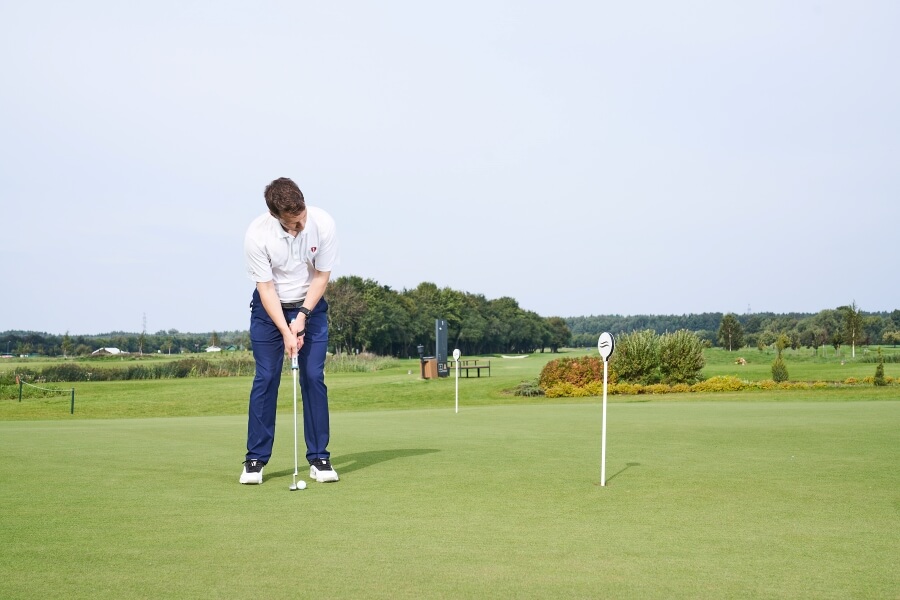How to Build Real Confidence in Golf (That Holds Up Under Pressure)
Everyone wants to build confidence in golf, but it’s not as easy as going to the range and beating a bucket of balls.
There needs to be a strict, well-planned regime in place to build your confidence over time.
The good news about building confidence is that it can be done even on days when you’re not playing your best. In fact, this is where your confidence will be tested the most.
Understanding that this will happen and preparing properly with knowledge and practice is the only way to limit these types of days.
The first part of this guide is to help you build confidence through better routines before, during, and after a round. The second part gives you specific drills to perform on the range that will directly build confidence if done correctly.
Building Confidence in Golf (Key Takeaways)
Start by getting an overview of what to work on when trying to build confidence in golf. These key takeaways will get you on the right track from the beginning.
- Building confidence is the product of a good mindset and healthy mental habits.
- Work on improving your confidence through practice, just as you would with any other aspect of golf.
- You don’t need the golf course or the driving range to boost your confidence in golf.
- Use technique to maximize your confidence on the course, no matter your current confidence level.
- Be prepared to handle the ups and downs of any kind of golf that gets thrown at you.
Contents
- Understanding the Role of a Confident Mindset in Golf
- Building Confidence Through Consistent Practice
- Preparing for Success Before You Hit the Course
- Have a Confident and Trusting Swing During Your Round
- Keeping Confidence Through Ups and Downs
- Drills to Build Confidence in All Areas of Golf
- Final Thoughts
Understanding the Role of a Confident Mindset in Golf
The mindset a golfer brings to the course is often the defining factor between success and frustration. Every golfer can control their mindset through self-talk.
Self-talk is the quiet commentary running through a player’s mind.
- Positive self-talk cultivates belief and resilience, allowing golfers to rebound from mistakes and stay focused on improvement.
- Negative or critical inner dialogue fosters anxiety and hesitation, often leading to self-fulfilling slumps. Recognizing and intentionally directing this internal conversation is a foundational step toward confidence.
Patience and realistic expectations go hand in hand with a strong golfing mindset. Golf is a game of continual learning, where immediate rewards are rare and progress can be uneven.
By setting achievable goals and understanding that improvement takes time, golfers can embrace the journey, celebrate small wins, and maintain the steady mindset needed to build true confidence on the course.
Confidence grows fastest with personalized feedback. Connect with golf coaches near you who can help guide your practice and mindset.
Building Confidence Through Consistent Practice
Like any other aspect of golf, if you practice efficiently, you will increase your odds of improving.
Practicing confidence is a little different than working on your slice; the results won’t be as obvious.
But if you stick to a regimented plan, you’ll see improvement over the course of a season that will stay with you throughout your entire golf career.
The Power of Repetition
Regular, purposeful practice forges neural pathways, ingraining proper movement patterns and making them more automatic under pressure.
Intentional practice ensures that every swing serves a purpose, reducing the likelihood of ingraining bad habits and boosting confidence each time a skill is mastered.
| Structured Practice | Random Practice |
|---|---|
| Focuses on specific skills | Mixes various shots/targets |
| Repeated drills for technique | Doesn’t simulate real-game situations |
| Easier to track progress | Encourages complacency |
Practicing under pressure, such as keeping score during practice rounds or creating challenging scenarios, prepares you for tournament environments where tensions are high.
By intentionally introducing pressure in practice, you simulate competition conditions and learn to manage stress, thus developing the confidence to perform consistently when it truly matters.
Always Celebrate Incremental Progress
To build confidence, you will have to “fake it until you make it” at the beginning. This doesn’t mean lying to yourself, but it does mean celebrating the little things.
If you make a big deal about small wins and try to forget about your mistakes, then your mind will believe you are better than you are and start performing that way.
- Celebrating small wins helps reinforce the techniques and habits that led to success, making it more likely you’ll repeat those behaviors consistently.
- Each minor accomplishment acts as a motivational boost, making practice sessions feel more rewarding and less like an endless grind, leading to longer, more focused engagement.
- When golfers see evidence of improvement, even in small increments, it helps replace self-doubt with genuine self-confidence, easing performance anxiety.
- Regularly acknowledging progress provides instant feedback, helping you to recognize what’s working and adjust your practice plans effectively.
- Focusing on small wins emphasizes learning and progress over perfection, reinforcing the idea that improvement is always possible through effort and perseverance.
Tech Builds Belief
We are lucky these days to have so many tools at our disposal. While we do want to keep things simple and not overdo it with the screens, some training aids will make a world of difference in your game when it comes to building confidence.
The most ground-breaking of them all is Hackmotion. This system uses delicate sensors to track your movement, then records and relays the information through the easy-to-use platform on any smartphone.

Its versatility and transparency are what make it so valuable to golfers who want to build confidence. It assists with all aspects of your game, from driver to putter, and addresses everything from mechanics to tempo, to confidence building with custom drill suggestions.
Use Hackmotion alongside a decent launch monitor, and you will have all the tech you need to build your confidence and lower your scores.
Preparing for Success Before You Hit the Course
Now that your practice routine is set, you still need to prepare correctly for each round.
Perform these steps in sequence to get your mindset right and your confidence overflowing before each round.
1. Sleep, Nutrition, and Physical Maintenance
Hopefully, you are already doing these things for overall health, but if not, let golf be the reason you choose a healthier lifestyle.
These simple daily tasks will put your mind in the right frame to tackle problems and handle conflict, helping you preserve confidence throughout an entire round of golf.
2. Structured Warm-Ups
Devise a warm-up routine that leaves you loving golf and loving your game. This is not the time to practice that low stinger or high draw you’ve been working on.
This is the time to ensure you have a few shots in the bag that you feel great about.
3. Goal Setting for Play
Setting goals for practice is different than setting goals for your playing rounds, but they follow a few standard guidelines.
- Always choose attainable goals
- No matter what happens, stick to your goals
- Always celebrate when your goals are achieved
Examples of playing goals should not be a set score. If your season goal is to break 100, don’t make it a goal of every round because that’s not achievable. Instead, set smaller goals that, when completed together, will result in your breaking 100.
Here are some examples of daily goals for a round;
- Have fewer than three 3-putts
- Hit 5 fairways
- Get up and down half of the time
- Perform my pre-shot routine on 95% of all shots
4. Visualization and Mental Rehearsal
Having a strong mental game and high confidence starts before you even arrive at the course.
If you know what track you’re playing, then go through each hole in your head and imagine how you will play them, shot-by-shot. This is a great exercise for the car ride to the course.
Even when you’re on the course, your pre-shot routine should include time to visualize the shot you want to create. This helps your mind more than any amount of practice swings put together, all the small details of each shot, without having to think about them consciously.
Have a Confident and Trusting Swing During Your Round
Practicing is one thing, but taking your game from the range to the course is quite another, and every golfer knows this.
Just know that if you’ve ever practiced something and then failed to bring it to the course, you are not alone.
While this will always be a part of the game, if you keep the following tips in mind, you will reduce these instances and produce a more confident and reliable swing day in and day out.
- Letting go during play: Trust in your practice and believe it will show up. Avoid the mindset of “Well, let’s see how this goes.” Instead, think: “Today could be my best round.” This will help you avoid overthinking as well, which can be just as damaging.
- Stick to your pre-shot routine: Even if the wheels come off, don’t give up; keep using it to try to create good shots. You can right the ship or at least finish on a high note to maintain your confidence going into your next round.
- Have fun: Of course, this phrase is very cliché, but that’s because it’s true. All the work you put into your game should result in more fun as well as lower scores. If you’re not finding the joy in every aspect of the game, then you will never improve, and worse, you won’t enjoy yourself. No matter what happens, shrug it off and have fun out there.
Keeping Confidence Through Ups and Downs
Golfers can maintain confidence on the golf course, even during slumps, by focusing on the process rather than the outcome.
Instead of fixating on score or past mistakes, direct your attention to each shot’s routine and technique. Establishing a consistent pre-shot routine helps calm nerves and reinforce a sense of control, making each shot a fresh opportunity. Breaking the game into manageable, singular tasks, you can stay present and avoid spiraling into frustration.
Positive self-talk also plays a crucial role in sustaining confidence. Replacing negative thoughts with affirming statements, such as “I can recover” or “I’ve played well before,” reinforces your belief in your abilities.
Accepting that mistakes are part of the game reduces pressure. Ultimately, embracing patience and self-compassion on tough days builds long-term confidence and enjoyment of the game, even amid temporary setbacks.
Want expert help building lasting confidence in your swing? Find golf coaches and lessons near you who use HackMotion for more data-driven improvement.
Drills to Build Confidence in All Areas of Golf
Building confidence in golf with drills is challenging. The tendency among all golfers is to slowly shift their focus to mechanics, forgetting that they are there to learn how to adapt and adjust.
These drills will help your mechanics, but they will help even more if you apply real golf concentration to them and a structured plan.
Skipping Stones Drill (Driver)
Use this drill as a warm-up to your long clubs. It helps build confidence from the beginning by focusing on your entire body rather than a single movement.
It will also help slicers swing from the inside out. The casual nature of the drill means everyone can and should do this, no matter their skill level.
- Video Timestamp: 3:37 – 4:55
Skipping Stones Drill – Step by Step
- Take your normal stance at address with your driver.
- Without changing your posture too much, release your grip and extend your lead arm straight out in front of you.
- Use your driver to brace your lead arm, creating a 90-degree angle between your arm and your driver.
- While keeping your lead arm and driver still, mimic your backswing with your trailing arm using your torso and lower body.
- On the downswing, release your trailing wrist, arm, shoulder, and hip underneath your stable and secure lead arm.
- You won’t get to a full follow-through, but the sensation should activate the entire trailing side of your body (right side for right-handed golfers) to work through the impact zone with confidence.
Towel Compression Drill (Irons)
The best way to build confidence with your irons is through consistent contact. If you know you’ll hit it solidly, then controlling distance and trajectory are much easier.
Stay focused on how you strike the ball with this drill. If you want to address mechanics, you can use Hackmotion, which will record your movements so you can review them later with dedicated focus.
- Video Timestamp: 1:16 – 3:44
Towel Compression Drill – Step by Step
- Lay a small golf towel down about eight inches behind your ball.
- Hit iron shots as you normally would on the course, but stay focused on compressing the ball and hitting the middle of the club face.
- Once you’ve done 10 in a row, move the towel slightly closer to the ball.
- When you’re hitting shots where the towel is only a couple of inches away, you will have gained incredible confidence.
Par 18 Game (Short Game)
Chipping drills are not very popular among amateur golfers, but to be truly confident in your golf game, you’ll need to chip well.
This drill is designed to get your experience, not work on technique. The more chips from different lies, angles, elevations, etc., you get, the better at chipping you’ll be.
Par 18 Game Drill – Step by Step
- Either by yourself or with a playing partner, drop a ball anywhere around the practice green and decide on a hole to play to.
- Using your chipping routine, play a shot to your chosen hole and try to get up and down.
- Getting up and down is a par, taking three shots is a bogey, etc.
- Keep score throughout 18 holes and see how you did compared to your last score or compared to your playing partner.
Ladder Drill (Putting)
If you could only have confidence in one aspect of your game, let it be putting. Although not the flashiest part of golf, putting makes or breaks scores.
The good news with putting is you don’t need to work on mechanics much, especially if you’re using the Hackmotion putting drills.
But what you do need with this drill is concentration, awareness, and confidence to succeed.
Ladder Putting Drill – Step by Step
- Lay down an alignment stick parallel to your putting line about 20 feet away.
- Lay down a second alignment stick parallel to the first, but about 10 feet closer to you.
- Line up your putt so you can roll the ball past the first alignment stick without having to bounce over it.
- Play your first putt so it passes the first alignment stick but stays short of the second.
- Play your second putt so it passes your first putt but still stays short of the second alignment stick.
- Play your third putt so it passes your second putt but still stays short of the second alignment stick.
- Continue this pattern until one of your putts comes up short of the previous putt or passes the second alignment stick.
- Record your score to compare against yourself or others.
Final Thoughts
Building confidence in golf is challenging. Even using the tips and drills above, it may take some time. But once you have confidence, it’s tough to shatter it (even though golf will try). Your confidence will lower your scores and also help you enjoy the game more.
Making your practice count by staying focused and tracking progress is key, and it’s made much easier with Hackmotion. While you’re working on getting your mind in the zone for each shot, Hackmotion is recording your every movement. You can review later, along with the suggested drills that target your specific needs.
Having Hackmotion working with you while you build confidence will only help you get there sooner. Before you know it, you’ll be shooting the best scores of your life.













